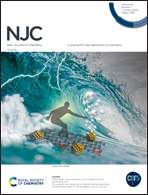Rapid mass production of iron nickel oxalate nanorods for efficient oxygen evolution reaction catalysis†
Abstract
The NiFe layered-double-hydroxide (NiFe-LDH) and the NiFe metal–organic framework (NiFe-MOF) demonstrate the best catalytic activity among NiFe-based materials for the oxygen evolution reaction (OER), which is important for efficient hydrogen production. However, the preparation processes of these materials are usually cumbersome and have a low yield, which eliminates their most critical advantage of being low cost. We propose a method for rapidly and efficiently preparing porous (Ni0.5Fe0.5)C2O4 nanorods with an excellent OER catalytic performance. The overpotential of (Ni0.5Fe0.5)C2O4 is 266 mV at 20 mA cm−2 under alkaline conditions, and the Tafel slope is 54.39 mV dec−1. Furthermore, analysis of the changes in the surface properties of the material before and after catalysis determined that the real active material is (Ni0.5Fe0.5)(OH)x(C2O4)1−x. Using a simple scaled-up experiment, (Ni0.5Fe0.5)C2O4 is mass-produced (40 g) via direct synthesis in 5 min. The composition and performance of the mass-produced sample are analysed under the same conditions, and (Ni0.5Fe0.5)C2O4 still has a good catalytic performance and its composition has not changed. The efficient synthesis of (Ni0.5Fe0.5)C2O4 nanorods with a porous structure provides a new option for the development of commercial catalysts using non-precious metals.



 Please wait while we load your content...
Please wait while we load your content...